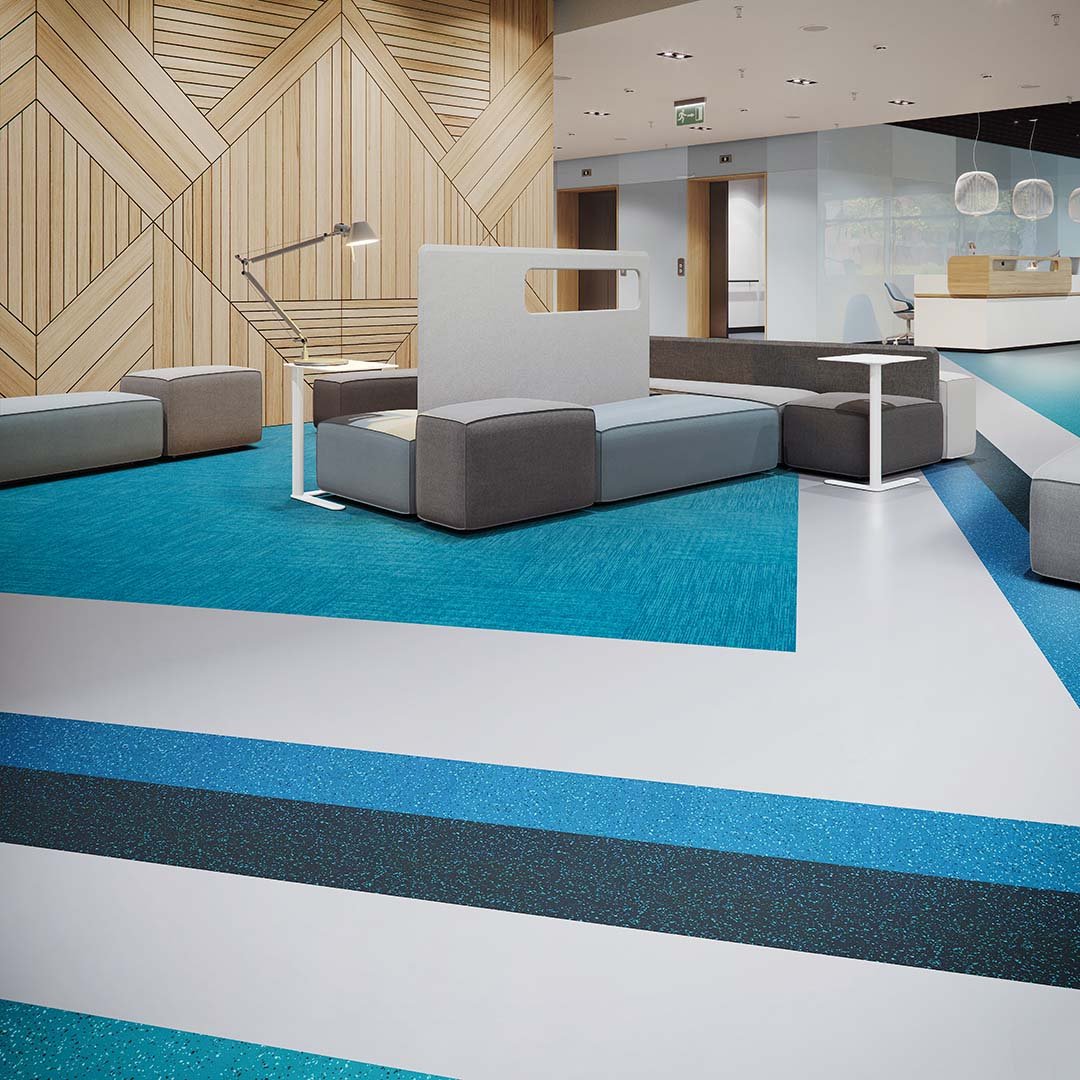If you’re considering whether to install rubber sheet or tile flooring, this article is for you. Like any flooring option, rubber has pros and cons. It performs well in high traffic areas, has good acoustics, and low maintenance costs. On the other hand, it has a higher price tag up front and requires dry fitting during installation. This article will give you an in depth look at these points along with where and how rubber flooring is used.
Where is Rubber Flooring Most Commonly Used?
Because of its durability and safety features (among others) there are three sectors where you often see rubber flooring—education, fitness, and healthcare. It’s been a popular product in the education sector for many years. You’ll see it in preschools, primary schools, and universities. Health clubs and gyms often choose rubber flooring. And you’ll find it in hospitals from the individual rooms to the cafeterias and common areas. Rubber flooring facilitates the needs of these large and highly trafficked spaces well.
Related: The Designers Ultimate Guide to Specifying School Flooring
Color Anchor Rubber Collection, ColorScape
When to Use Rubber Sheet Vs. Rubber Tile
Making the decision to go with rubber sheet versus tile has to do with aesthetics and application. Generally speaking, we see more sheet in healthcare, and more tile in education. If it’s a large open space, we typically recommend rubber sheet because there are less seams. Having less transitions is a good thing, because it means less opportunity for hazardous material buildup. That being said, sometimes we see large open areas that use tile. With modular versions of the product, you have more design flexibility with things like color and quarter turning, so even in large open spaces tile is sometimes chosen to create a certain look.
Related: Top Ten Decisions to Make When Selecting Healthcare Flooring
Related: The Best Flooring For Schools and Education Spaces
Benefits of Rubber Flooring
Rubber has plenty of benefits, here is the breakdown:
- Durability: Whether it’s sheet or tile, rubber flooring holds up particularly well in high traffic areas over long periods of time, so it makes for a good investment. It’s also resistant to indention, not just from foot traffic, but from things like hospital beds or heavy rolling wheels.
- Comfort: Another benefit of rubber is comfort under foot. We get a lot of feedback on this feature. It feels nice to walk on rubber flooring, and it’s naturally slip resistant. This makes it a safer option when there are a lot of people walking around.
- Acoustics: Because rubber is a bit softer than some of the other hard surface products, it ends up being quieter. The sound absorption of rubber is particularly useful in large open areas where there may be an empty echoic sound.
- Self-Migrating Wax: A particularly unique feature of rubber flooring is self-migrating wax. Rubber has built-in waxes that help dirt and grime release from the floor surface making it easier to keep clean. It’s similar to how your skin produces oil. As the product ages, the waxes continue to migrate to the surface, so you don’t need to take that extra step of waxing the floors. This results in lower maintenance costs over the life of the product.
- Sustainability: Rubber is a sustainable product. It’s harvested from rubber sap that comes out of rubber trees. Tapping trees for sap does not necessarily harm them. As a result, manufacturing rubber ends up being easier on the environment than other flooring materials like PVC (polyvinyl chloride). There are folks out there that want and appreciate non-PVC products, and the biggest and most popular option is rubber.
- Design Options: Rubber flooring at Mannington Commercial has so many options! Customers can choose their stair tread, wall base, transitions, landing tiles, and whether they want tile or sheet. There are tons of colors and formats that can be coordinated. These come in handy when you need to transition from one type of flooring to another or from one space to another. Imagine you have a color spec on the floor, and when you go into the stairwell, you have stair tread and landing tile that coordinates with the color you just left. Facilitating all of the design options can really help tie a space together. Some people might find the number of options overwhelming, but Mannington has tools to help.
Related: Design Solutions: Get Help Designing Your Floor
.jpg?width=1080&name=Teles_%20BeachStone_853_CoastalFog_851_DewDrop_850_roomscene%20(1).jpg)
Teles Collection, Beach Stone, Costal Fog, Dew Drop
Drawbacks of Rubber
There are three disadvantages that have been associated with rubber flooring. The main downside is cost. Rubber typically costs more upfront. But over the life of the product, the cost is actually less because of how long it lasts along with the lower maintenance costs.
And while there are more design options than ever before, rubber has a reputation of being visually limited. Mannington has products like Teles that have overcome the visual limitations of speckled rubber tile with new textures and patterns.
And the last drawback involves installation. Installing rubber floor requires dry fitting the product before installation.
Installation Issues
In terms of installation difficulty, you could say rubber flooring is a little less forgiving than something like LVT (Luxury Vinyl Tile), but it’s a very subtle difference. We recommend dry-laying rubber tile or sheet before its installed. Because rubber is made from natural materials, there's a little more variation than there is with PVC based printed products. There are cases where LVT would be more difficult to install than rubber and vice versa. You need experienced installers putting down any commercial hard surface product, because it requires knowledge of the adhesive and subfloor.
Related: The Best and Worst Places for Rubber Flooring and Costly Installation Mistakes to Avoid
Some people assume that rubber doesn’t work in places where there is existing slab moisture, but that is not the case. The adhesive system has more to do with moisture tolerance than the flooring product itself. Whatever the product, whether it’s LVT or rubber, the sub floor must be properly prepped and the correct adhesive for the product must be used for adequate moisture tolerance.
All in all, rubber is a great flooring option, especially if you are dealing with large open spaces or high traffic areas. In the end, it’s worth the extra upfront cost. It’s a very durable product that has unique color and design elements, and it’s made from natural materials. If you have questions, or if you would like customized information about flooring for your project, contact a Mannington Commercial Representative.
A Guide to Rubber Stairways and Wall Base
In this guide you'll learn about the 3 main types of rubber and where to use them. You'll also learn how to design stairways to be in compliance with IBC regulations. Then we'll look at how to specify rubber wall base to finish out your space with style and performance.


